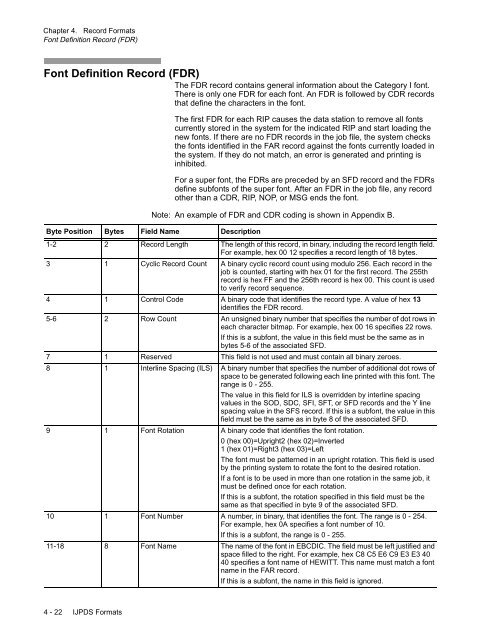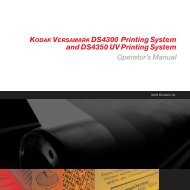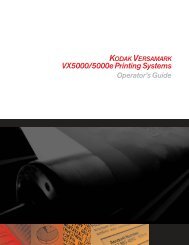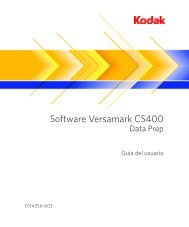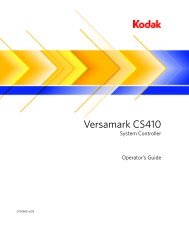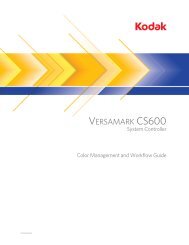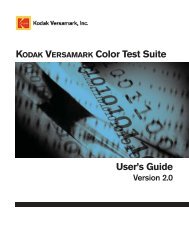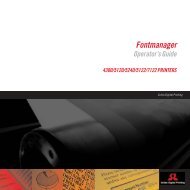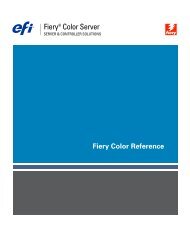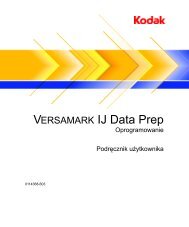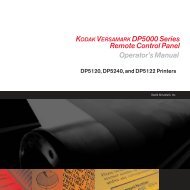You also want an ePaper? Increase the reach of your titles
YUMPU automatically turns print PDFs into web optimized ePapers that Google loves.
Chapter 4. Record Formats<br />
Font Definition Record (FDR)<br />
Font Definition Record (FDR)<br />
The FDR record contains general information about the Category I font.<br />
There is only one FDR for each font. An FDR is followed by CDR records<br />
that define the characters in the font.<br />
4 - 22 IJPDS Formats<br />
The first FDR for each RIP causes the data station to remove all fonts<br />
currently stored in the system for the indicated RIP and start loading the<br />
new fonts. If there are no FDR records in the job file, the system checks<br />
the fonts identified in the FAR record against the fonts currently loaded in<br />
the system. If they do not match, an error is generated and printing is<br />
inhibited.<br />
For a super font, the FDRs are preceded by an SFD record and the FDRs<br />
define subfonts of the super font. After an FDR in the job file, any record<br />
other than a CDR, RIP, NOP, or MSG ends the font.<br />
Note: An example of FDR and CDR coding is shown in Appendix B.<br />
Byte Position Bytes Field Name Description<br />
1-2 2 Record Length The length of this record, in binary, including the record length field.<br />
For example, hex 00 12 specifies a record length of 18 bytes.<br />
3 1 Cyclic Record Count A binary cyclic record count using modulo 256. Each record in the<br />
job is counted, starting with hex 01 for the first record. The 255th<br />
record is hex FF and the 256th record is hex 00. This count is used<br />
to verify record sequence.<br />
4 1 Control Code A binary code that identifies the record type. A value of hex 13<br />
identifies the FDR record.<br />
5-6 2 Row Count An unsigned binary number that specifies the number of dot rows in<br />
each character bitmap. For example, hex 00 16 specifies 22 rows.<br />
If this is a subfont, the value in this field must be the same as in<br />
bytes 5-6 of the associated SFD.<br />
7 1 Reserved This field is not used and must contain all binary zeroes.<br />
8 1 Interline Spacing (ILS) A binary number that specifies the number of additional dot rows of<br />
space to be generated following each line printed with this font. The<br />
range is 0 - 255.<br />
The value in this field for ILS is overridden by interline spacing<br />
values in the SOD, SDC, SFI, SFT, or SFD records and the Y line<br />
spacing value in the SFS record. If this is a subfont, the value in this<br />
field must be the same as in byte 8 of the associated SFD.<br />
9 1 Font Rotation A binary code that identifies the font rotation.<br />
0 (hex 00)=Upright2 (hex 02)=Inverted<br />
1 (hex 01)=Right3 (hex 03)=Left<br />
The font must be patterned in an upright rotation. This field is used<br />
by the printing system to rotate the font to the desired rotation.<br />
If a font is to be used in more than one rotation in the same job, it<br />
must be defined once for each rotation.<br />
If this is a subfont, the rotation specified in this field must be the<br />
same as that specified in byte 9 of the associated SFD.<br />
10 1 Font Number A number, in binary, that identifies the font. The range is 0 - 254.<br />
For example, hex 0A specifies a font number of 10.<br />
If this is a subfont, the range is 0 - 255.<br />
11-18 8 Font Name The name of the font in EBCDIC. The field must be left justified and<br />
space filled to the right. For example, hex C8 C5 E6 C9 E3 E3 40<br />
40 specifies a font name of HEWITT. This name must match a font<br />
name in the FAR record.<br />
If this is a subfont, the name in this field is ignored.


